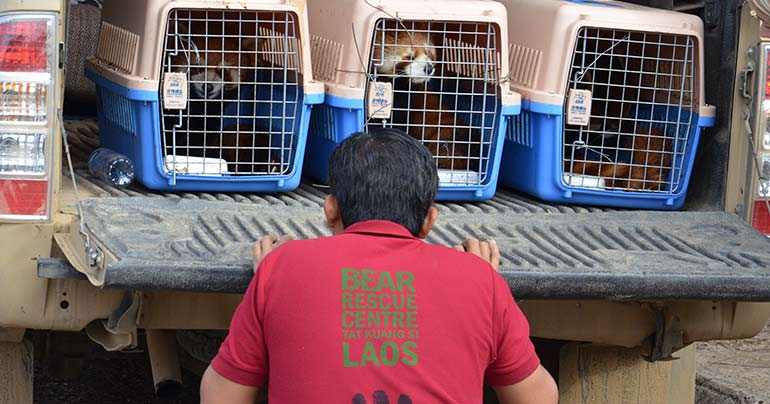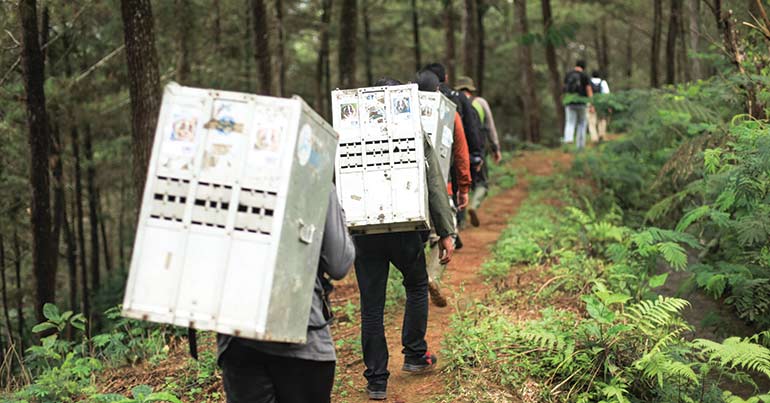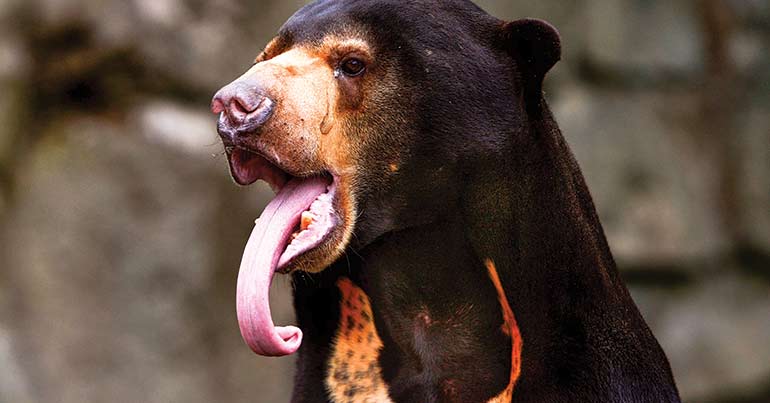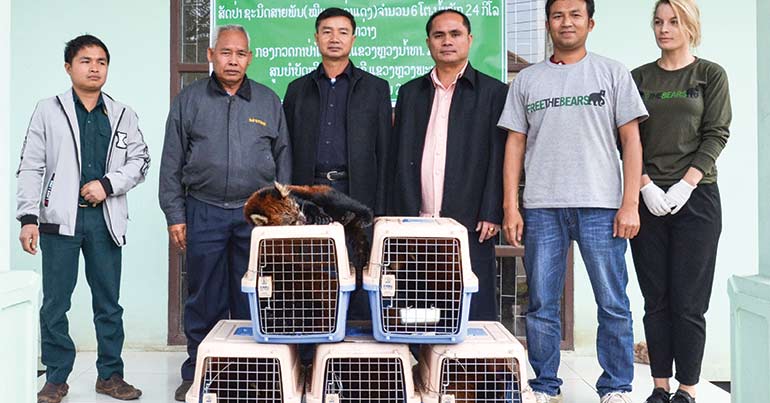In a one-minute video uploaded to YouTube in 2015, a beautiful, copper-coloured creature clumsily bounces through a snow-filled zoo enclosure in true exhibitionist style. Displaying its snow-covered belly and large, outstretched paws to the camera, the red panda’s antics struck a chord with many of the four million sets of eyes that have watched the clip.
The comments left below the video are dominated by paeans to the bushy-tailed animal’s cuteness. “I WANT ONE!” screams one ecstatic fan. “Is it possible 2 own a red panda or any panda as a pet?” wonders another. “My Siberian Husky would love one of these as a playmate!” states a particularly convivial viewer.
Dim-witted but harmless, one might surmise about such comments.
On 12 January, six live red pandas were seized from a minivan in northern Laos about 19km from the country’s border with China. Free the Bears, the wildlife protection organisation that aided the Provincial Department of Forestry Inspection in the rescue operation, says it’s not only the first seizure of red pandas in the country, but the largest red panda confiscation ever recorded. Three died within days, and the rest were delivered to the Luang Prabang Wildlife Sanctuary for treatment.
The International Union for the Conservation of Nature (IUCN), the global body that identifies species’ status of conservation, lists red pandas as officially ‘endangered’, estimating a 50% decline in the mammal’s population over the past two decades.

According to Rod Mabin, regional communications director of Free the Bears and part of the team that supported the rescue operation in Laos, the unprecedented nature of the capture points to a worrying increase in demand for the animals as exotic pets. “There’s very little record of live red pandas being moved around. This is really unusual – the size, six, is historic. There’s never been so many… We never in our wildest dreams expected that we would see red pandas,” he says, referring to the fact that the red panda is native to the eastern Himalayas and southwest China and is not known to live in the wild in Laos. It is assumed that the animals were en route to Thailand, a hub for wildlife trafficking.
A 2015 study by the Nocturnal Primate Research Group at Oxford Brookes University explored how social media and online videos can change an audience’s perception of the slow loris
“In the past, there was very little knowledge of the animals, but now there’s greater knowledge and awareness, and I think that’s from a lot of social media, from YouTube clips,” Mabin says.
Damber Bista, programme manager at the Red Panda Network, an organisation dedicated to protecting the species, agrees that “this kind of video and information plays some role in motivating people to rear and keep the animals as pets” and that their cuddly features and seemingly playful personality is misleading as most of the videos show cubs below the age of two, after which they become more aggressive. “They are solitary animals,” says Bista. “They love loneliness.”
The slow loris, native to countries across Southeast Asia, particularly Malaysia and Indonesia, has shot to similar levels of social media fame. These furry, nocturnal creatures, about the size of a rabbit, have captured the attention of millions with their irresistibly wide eyes and slow, delicate movements. The IUCN classifies all eight species of the slow loris between ‘vulnerable’ and ‘critically endangered’, and the Convention on International Trade in Endangered Species of Wild Fauna and Flora (Cites) bans all international trade of the animal.
A 2015 study by the Nocturnal Primate Research Group at Oxford Brookes University explored how social media and online videos can change an audience’s perception of the slow loris by examining the content of videos in relation to viewer engagement, measured in ‘thumbs ups’ and comments. In all 100 of the videos studied, about a third of which came from Japan, at least one of the ‘five freedoms’ of animal welfare was violated, and videos where harmful behaviour was shown were statistically met with a higher proportion of positive audience engagement.

The most popular videos, for example, show the loris raising its small, clawed hands above its head as it is scratched by an amused owner. This is, in fact, a defence posture.
The most popular videos, for example, show the loris raising its small, clawed hands above its head as it is scratched by an amused owner. This is, in fact, a defence posture. The videos were usually met with comments describing the loris as “cute” or expressing a longing to own one as a pet, despite the videos showing all five signs of mistreatment for animals unsuitable to be kept as pets: human contact; an unnatural environment; signs of stress; daylight; and separation from members of the same species.
A more recent study from July last year by the same research group found that the use of the slow loris as a photo prop had gained traction as far away as Turkey – 7,000km from its natural habitat of Southeast Asia.
Christine Rattel, programme advisor at International Animal Rescue’s slow loris centre in West Java, Indonesia, the biggest centre for slow lorises in the world, agrees that this kind of engagement is built on misinformation. “I think that the main problem [when] wildlife is presented in cute ways is that people just don’t understand they are not pets, they are not domesticated,” she says. “People don’t think in general – it’s just childish… They see slow lorises are cute, they want it.”
While difficult to quantify the exact statistical impact of these kinds of videos, Rattel says: “We did see a trend in, especially younger people, maybe age 18 to 35, [obtaining a slow loris in Indonesia]. They seem to be, demographically, the kind of people who are most interested in it, and that seems to fit in with the kind of people that would watch YouTube videos.”
Rattel adds that social media platforms’ attempts to halt the posting of animal welfare violations – only in December did Instagram introduce a function for reporting animal abuse – are often hampered by their staff’s lack of knowledge. “We were urging [YouTube] to take these videos down, but they just don’t see the necessity,” she says. “They just don’t see that this is torture for the animals because no one got beaten up, there’s no blood… I don’t think it’s really taken seriously.”

Aside from the fetishisation of what amounts to animal abuse, social media platforms have also created a tricky new field for regional and international law enforcement agencies. With the trade starting to shift online and away from physical markets, traders are discovering new means of operation in which they can more easily avoid detection and expose a larger audience to a wider number of species.
A report published in 2016 by Traffic, the wildlife trade monitoring network, found that closed Facebook groups, where only users who are accepted into the group by an administrator can view the content, are providing a platform for a wildlife trade in peninsular Malaysia, where, unlike many other countries in the region, physical wildlife markets had never really existed. Among the 14 Facebook groups monitored over a five-month period, which had a combined 68,000 members, Traffic’s researchers found more than 300 wild animals advertised for sale, and almost half of the postings were declared illegal under Cites or Malaysian law.
Kanitha Krishnasamy, acting regional director for Traffic in Southeast Asia and co-author of the report, calls social media “this new beast that is making the issue of wildlife trade a lot more complicated”.
The report suggests that traders have turned to Facebook rather than commercial sites where trade may be more explicitly banned – Chinese e-commerce giants Alibaba, Taobao and Tencent pledged zero-tolerance to illegal trading on their sites in 2012 – because it offers a level of control in terms of who can view the advertisements of animals for sale, as well as a layer of invisibility.
In one advert posted to a closed group, a grainy photo shows the tiny body of a leopard cat gripped by the hand of a faceless man. “Tame. Two male, eyes aren’t open yet… One female has opened her eyes… MYR 800 [$205] each fixed price… Anyone interested please pm me first…” the caption reads.
In another, a caged Sunda slow loris is accompanied by surprisingly casual words: “Greetings, sorry, admin ran out of topic, for release to a new owner too busy with work, no time to play, semi-tame – anything, please whatsapp…” says the description.

Written in plain language with casual references to pick-up destinations and contact information more suited to a used furniture sale than a wildlife-trading forum, the adverts suggest the ease with which these transactions take place – with seemingly no fear, or no knowledge, of the legal consequences. The descriptions are so bare that, often, the species of the animal itself is not even mentioned.
Rattel says that the move online makes it incredibly difficult to identify the level of trade that is occurring. “A few years ago, it was easier – 300 animals we could see on display at the market [in Indonesia], whereas last year we didn’t see a single one,” she says. “The trade in the market might still be there, but it’s hidden.”
The social media trade has also marked a shift in the kinds of people selling the animals. “You can’t go after every person who has one loris. You have to figure out who is a real trader and who is maybe just doing it to make some extra cash,” says Rattel.
With increasing calls for social media platforms to do more to crack down on illegal trade, campaigners are also harnessing social media’s capacity for outreach and education to inform the public of the danger facing these animals. International Animal Rescue’s ‘Tickling is Torture’ campaign, for instance, urges internet users to stop sharing slow loris videos online and to report content that may be damaging.
“Social media owners and business players are coming on board to try to help the situation, but everybody is really aware that this is very much a global problem,” says Krishnasamy.
She concedes that with the speed of transactions and the number of young animals constantly entering the trade, NGOs and law enforcement agencies will always be playing catch-up. However, she is sure that there is a solution. “It can be stopped. A number of enforcement successes have occurred in Malaysia, Thailand, Indonesia and the Philippines,” she says. “All parties [must] come together and find a solution… including Facebook, including government agencies, including civil society organisations who are monitoring these trends.”


